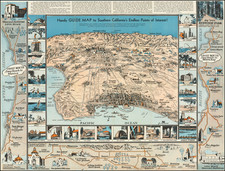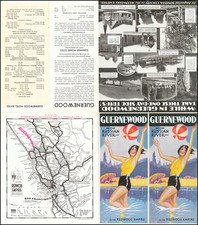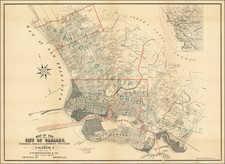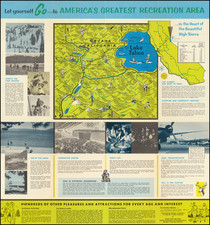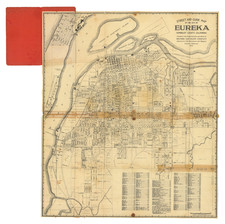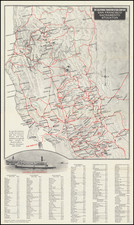Sun-Kissed, Ocean-Washed, Mountain-Girded, Island Guarded
Fine early promotional / cadastral map and brochure for Hope Ranch, in Santa Barbara.
The map shows the area south of the State Highway (101) and Holister Avenue, subdivide into residential and larger agricultural tracts. A number of the larger tracts are designated Lemon Tracts or simple Lemons, with the name of the owner and number of trees given.
The map identifies the names of each of the homeowners in the Ranch. Some of the larger lots on Lago Drive and Las Palmas Driver are owned by Santa Barbara Estates Inc. or do not list an owner.
The bridal path and polo grounds are shown, as is the Beach Park and Bath House.
On the verso are the names of some of the home owners and early photos.
Hope Ranch History
The first private owner of land that would become known as Hope Ranch was Lt. Narcisco Fabregat of the Santa Barbara Presidio who was called to Santa Barbara to fight the notorious pirate, Bouchard. Fabregat received the land in a grant from Governor, Manuel Micheltorena on May 16, 1843.
In 1861, Thomas Hope (after whom the Ranch was ultimately named) bought the property for a sum of $8,000. Hope was an Irishman who immigrated to the United States when he was 16 and began working in the cattle and sheep industry. He turned this into a prosperous business and settled in Santa Barbara after spotting the ideal location for his flock of sheep that had grown to 5,000 strong. The need for wool to make uniforms for the soldiers fighting in the Civil War created a lucrative market for his operation.
After Thomas Hope died in January, 1876, Hope divided the land among his six children. In 1887, the owners of the Southern Pacific Railroad purchased a portion of the land for $250,000 from Hope's widow and laid railroad tracks and sta5rted plans for a tourist hotel surrounded by large estates. By 1899, the idea for the hotel had been scrapped, but development continued, with construction of a 3,000 foot water tunnel and irrigation system.
By 1908, the company was ready to market the land according to subdivision plans completed by A.W. Dozier. However, the initial sales were poor and most activity in Hope Ranch centered around the Potter Country Club, which would later be renamed the La Cumbre Gold and Country Club, which was founded in 1908.
In 1919, G. Maurice Heckscher next attempted to complete the Hope Ranch Development, but was unsuccessful, optioning the eastern half of the project to another developer, who attempted to create a plan which included hundreds of 50 foot wide lots facing the Ocean, rather than the original 89 lots created by the Dozier Plan. This project also failed.
In 1923, Harold Chase acquired the eastern portion and alter the full ranch. He proceeded with the installation of roads, utilities and bridle trails and laid the groundwork for the creation of a residential community. He then began the process of selling lots in the Ranch to people who wished to make this their home. Within 20 years, the first 100 houses had been constructed in the Ranch.











